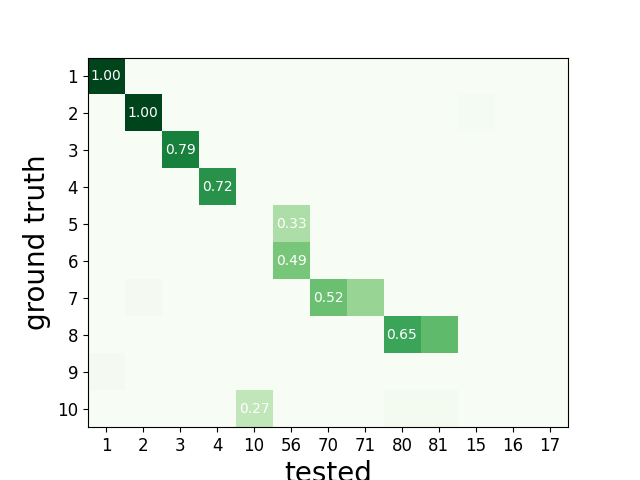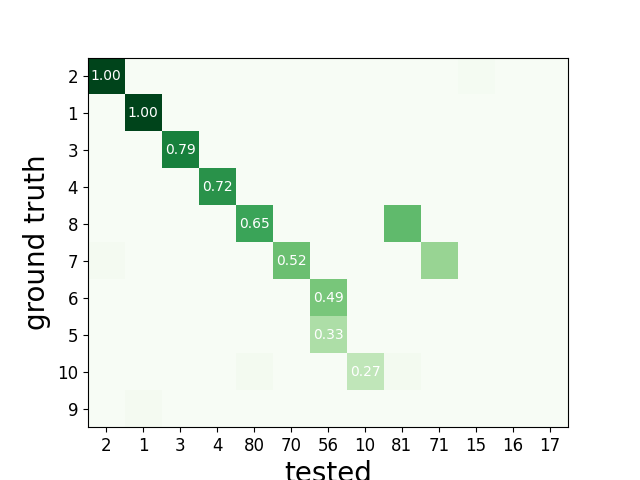Note
Click here to download the full example code
Explore sorters weaknesses with ground-truth comparison¶
Here a synthetic dataset will demonstrate some weaknesses.
Standard weaknesses :
not all units are detected
a unit is detected, but not all of its spikes (false negatives)
a unit is detected, but it detects too many spikes (false positives)
Other weaknesses:
detect too many units (false positive units)
detect units twice (or more) (redundant units = oversplit units)
several units are merged into one units (overmerged units)
To demonstrate this the script generate_erroneous_sorting.py generate a ground truth sorting with 10 units. We duplicate the results and modify it a bit to inject some “errors”:
unit 1 2 are perfect
unit 3 4 have medium agreement
unit 5 6 are over merge
unit 7 is over split in 2 part
unit 8 is redundant 3 times
unit 9 is missing
unit 10 have low agreement
some units in tested do not exist at all in GT (15, 16, 17)
Import
import numpy as np
import pandas as pd
import matplotlib.pyplot as plt
import seaborn as sns
import spikeinterface.extractors as se
import spikeinterface.sorters as ss
import spikeinterface.comparison as sc
import spikeinterface.widgets as sw
from generate_erroneous_sorting import generate_erroneous_sorting
Here the agreement matrix
sorting_true, sorting_err = generate_erroneous_sorting()
comp = sc.compare_sorter_to_ground_truth(sorting_true, sorting_err, exhaustive_gt=True)
sw.plot_agreement_matrix(comp, ordered=False)

<spikeinterface.widgets._legacy_mpl_widgets.agreementmatrix.AgreementMatrixWidget object at 0x7f29755f8400>
Here the same matrix but ordered It is now quite trivial to check that fake injected errors are enlighted here.
sw.plot_agreement_matrix(comp, ordered=True)

<spikeinterface.widgets._legacy_mpl_widgets.agreementmatrix.AgreementMatrixWidget object at 0x7f298c0467f0>
Here we can see that only Units 1 2 and 3 are well detected with ‘accuracy’>0.75
print('well_detected', comp.get_well_detected_units(well_detected_score=0.75))
well_detected [1, 2, 3]
Here we can explore “false positive units” units that do not exists in ground truth
print('false_positive', comp.get_false_positive_units(redundant_score=0.2))
false_positive [15, 16, 17]
Here we can explore “redundant units” units that do not exists in ground truth
print('redundant', comp.get_redundant_units(redundant_score=0.2))
redundant [71, 81]
Here we can explore “overmerged units” units that do not exists in ground truth
print('overmerged', comp.get_overmerged_units(overmerged_score=0.2))
overmerged [56]
Here we can explore “bad units” units that a mixed a several possible errors.
print('bad', comp.get_bad_units())
bad [10, 56, 71, 81, 15, 16, 17]
There is a convenient function to summary everything.
comp.print_summary(well_detected_score=0.75, redundant_score=0.2, overmerged_score=0.2)
plt.show()
SUMMARY
-------
GT num_units: 10
TESTED num_units: 13
num_well_detected: 3
num_redundant: 2
num_overmerged: 1
num_false_positive_units 3
num_bad: 7
Total running time of the script: ( 0 minutes 0.318 seconds)